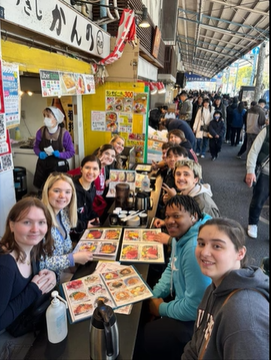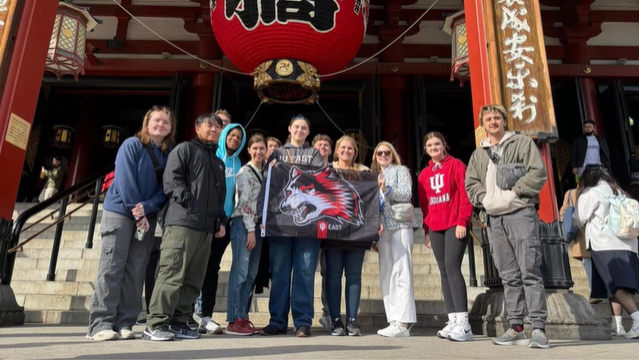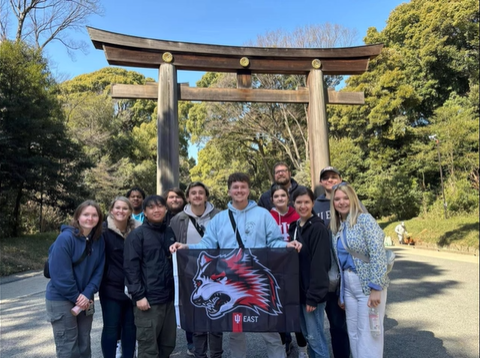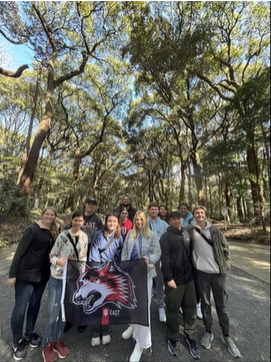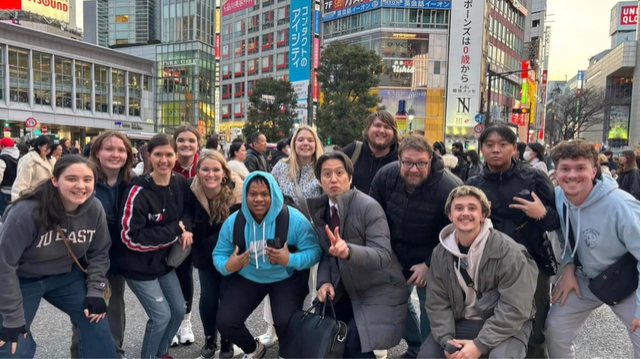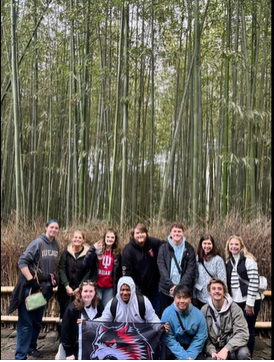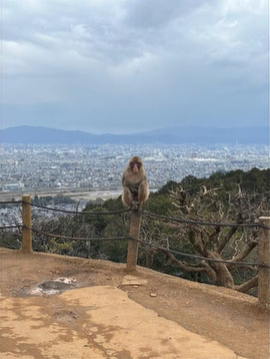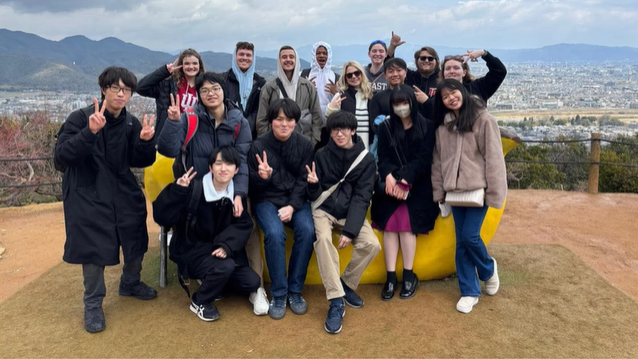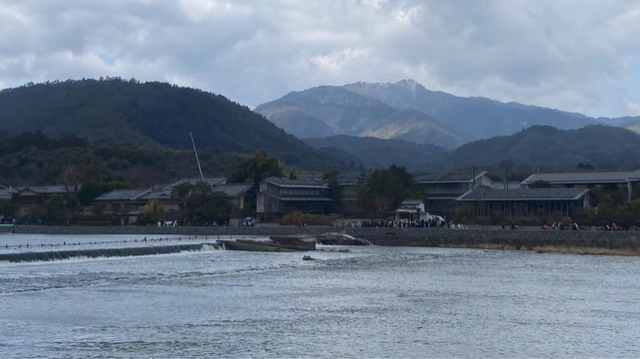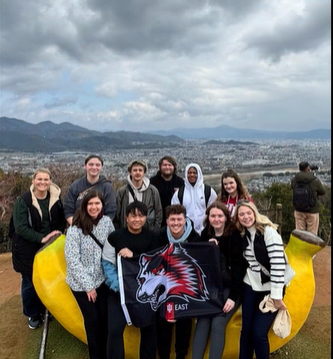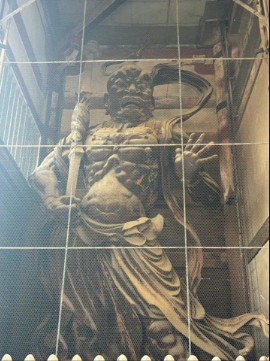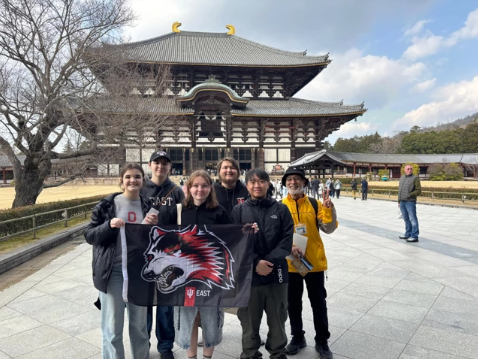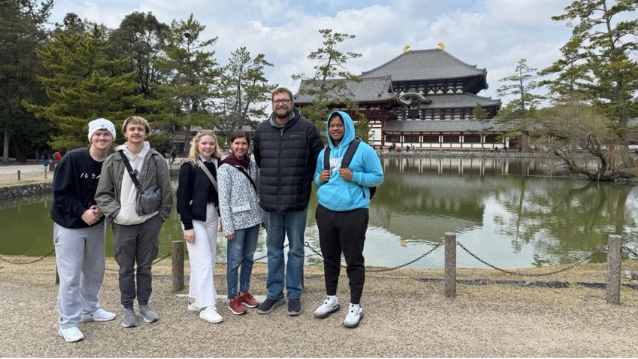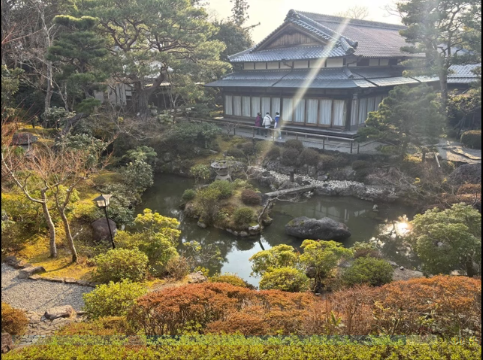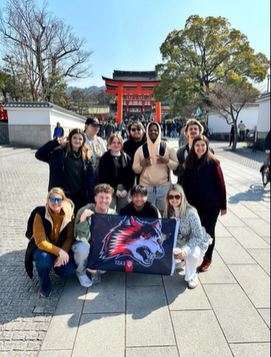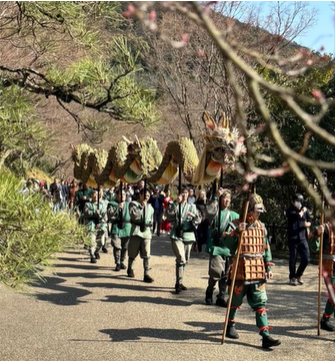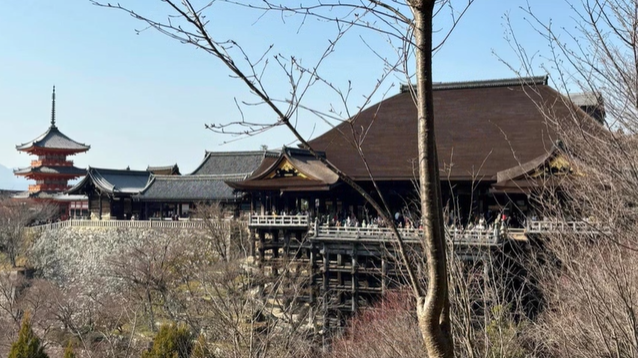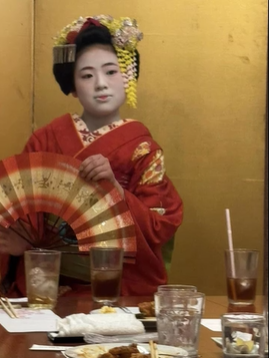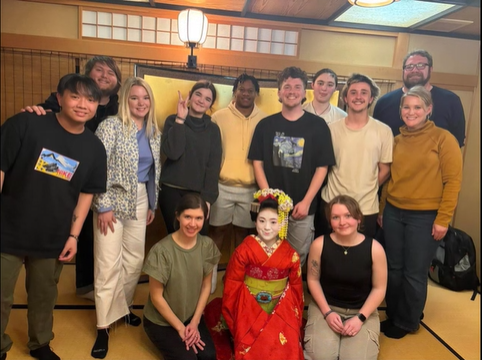4 Spring 2024: Fine Arts in Japan
This cross-listed course examined a broad survey of Japanese art history with emphasis on its influences from China, Japan, and more recently, the West. Taught by Professor Carrie Longley.
March 10, 2024 to March 17, 2024
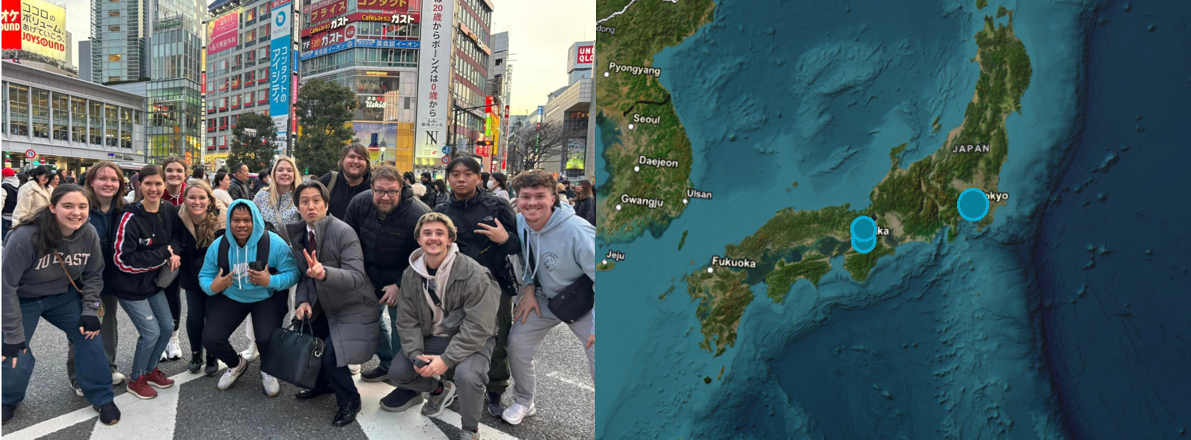
First Night in Tokyo
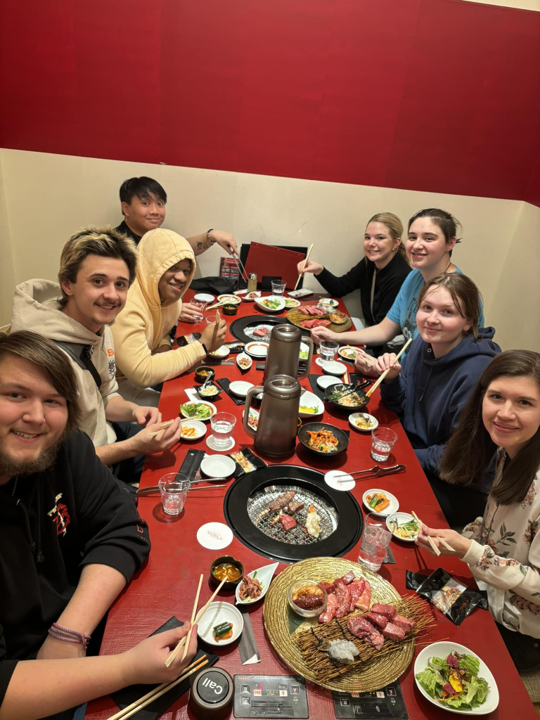
Students enjoyed Yakiniku, Japanese barbecue, after their flight into Japan.
First Day in Tokyo
Students explored a variety of iconic locations in Tokyo, including Tsukiji Market, the Asakusa District (Sensoji Temple and Tokyo SkyTree), the Imperial Palace, Meiji Jingu Shrine and Harajuku, the bustling Shibuya Area with its famous Scramble Crossing, and Odaiba.
Travelling to Kyoto

Students travelled from Tokyo to Kyoto on a bullet train at speeds as high as 185 miles per hour.
A Day in Arashiyama
Students ventured beyond Kyoto to Arashiyama, where they embarked on a mountain hike amidst snow monkeys and strolled through a captivating bamboo forest.
Visiting Nara
Students travelled to the original capital city of Nara, where they visited Kofukuji Temple, the Kasha-taisha Shrine, Wakakusayama Hill's foot former katana sword manufacturer’s shop, Todaiji's Great Buddha Hall, and Yoshikien Garden. Finally, they enjoyed an Okonomiyaki Dinner.
Final Day in Japan
Students went back to Kyoto for their final day in Japan, where they visited the Fushimi Inari Shrine, the Kyoto Ceramic Center, and witnessed a Blue Dragon Festival at the Kiyomizu-dera Temple. They also enjoyed a keiseki dinner and a Maiko performance from a performer named Fukunaru. They spent the evening watching Fukunaru dance, playing a traditional game, and making conversation.
Credits
Attributions listed alphabetically:
Information: IU East Fine Arts Facebook Page
Photos: IU East Fine Arts Facebook Page
Shibuya district, Tokyo
Shibuya district, TokyoDepartment store complex in a fashionable shopping district of Shibuya, Tokyo, Japan.
Tokyo, city and capital of Tokyo to (metropolis) and of Japan. It is located at the head of Tokyo Bay on the Pacific coast of central Honshu.
Source: Britannica
https://www.britannica.com/place/Tokyo
Tsukiji Market, located in central Tokyo, was the world’s largest wholesale fish and seafood market until its closure in 2018. It was renowned for its bustling tuna auctions and the wide variety of seafood available, attracting both local and international visitors. Today, the outer market remains a popular destination, offering fresh seafood, kitchenware, and traditional Japanese foods.
Source: https://www.tsukiji.or.jp/english/
Tokyo Sky Tree, broadcasting and telecommunications tower in Tokyo. At a height of 2,080 feet (634 metres), it was the world’s second tallest structure, after the Burj Khalifa in Dubai, at the time of its opening on May 22, 2012.
Source: Britannica
https://www.britannica.com/topic/architecture/Religious-architecture
Surrounded by a lush green forest right in the heart of Tokyo , this Shinto shrine is dedicated to Emperor Meiji (1852-1912) and Empress Shoken, who led Japan to become a modernized nation.
Source: Japan National Tourism Organization
https://www.japan.travel/en/spot/1666/
Kyōto, city, seat of Kyōto fu (urban prefecture), west-central Honshu island, Japan. It is located some 30 miles (50 km) northeast of the industrial city of Ōsaka and about the same distance from Nara, another ancient centre of Japanese culture.
Source: Britannica
https://www.britannica.com/place/Kyoto-Japan
Located in the northwestern area of Kyoto, Arashiyama draws many visitors for its world-renowned bamboo grove and beautiful scenery that changes with each season. The area is dotted with temples, old imperial villas, and famous historical sites, many of which are National Treasures, or have been recognized as World Heritage sites.
Source: Japan National Tourism Organization
https://www.japan.travel/en/spot/1142/
Nara, city, Nara ken (prefecture), southern Honshu, Japan. The city of Nara, the prefectural capital, is located in the hilly northeastern edge of the Nara Basin, 25 miles (40 km) east of Ōsaka. It was the national capital of Japan from 710 to 784—when it was called Heijō-kyō—and retains the atmosphere of ancient Japan.
Source: Britannica
https://www.britannica.com/place/Nara-Japan
Kofukuji Temple has four national treasure buildings: the five-story pagoda, the three-story pagoda, the Hokuendo, and the Tokondo.
Source: Japan National Tourism Organization
https://www.japan.travel/en/spot/1012/
Kasuga Taisha is considered one of the most sacred sites in all of Japan. As a place where numerous gods are enshrined, it attracts both devotees and tourists seeking an iconic Shinto experience.
Source: Japan National Tourism Organization
https://www.japan.travel/en/spot/1013/
With paths starting behind Todaiji Temple, Mt Wakakusa is easy to climb and rewards hikers with views as far as the Former Site of Heijokyo Imperial Palace. There is a small fee to enter one of the two main climbing trails, which take around 15 minutes to reach the midway observatory, then another 20 minutes to the summit, 342 meters above the city.
Source: Official Nara Travel Guide
https://www.visitnara.jp/venues/A00491/
The Great Buddha Hall (Daibutsu-den) was built in the centre of a vast enclosure of some 2 square miles (5 square km) with gates, pagodas, subsidiary buildings, and colonnades. It was an enormous wooden building measuring some 288 by 169 feet (88 by 52 metres) in ground plan.
Source: Britannica
https://www.britannica.com/topic/Todai-Temple
In Japanese cookery: a savoury pancake made with flour and eggs combined with other ingredients such as cabbage, meat, and seafood, cooked on a griddle, and served with various toppings such as dried seaweed flakes, pickled ginger, and Japanese mayonnaise.
Source: Oxford English Dictionary
https://www.oed.com/dictionary/okonomiyaki_n?tl=true
Dedicated to Inari, the deity of a good harvest and success in business, Fushimi Inari Taisha is the head of all of Japan's Inari shrines. The seemingly endless path of vibrant orange torii gates that line the approach to Mt. Inari makes for an impressive setting and is one of the most famous images of Japan.
Source: Japan National Tourism Organization
https://www.japan.travel/en/spot/1128/
Situated atop a small mountain on the east side of Kyoto, Kiyomizudera Temple offers a commanding view of the city. The temple's stage, supported by massive pillars, is one of the most famous images of Japan.
Source: Japan National Tourism Organization
https://www.japan.travel/en/spot/2199/
A highly ritual Japanese meal characterized by small portions, subtle flavors, artful presentation, and an emphasis on fresh seasonal ingredients.
Source: Merriam-Webster Dictionary
https://www.merriam-webster.com/dictionary/kaiseki

